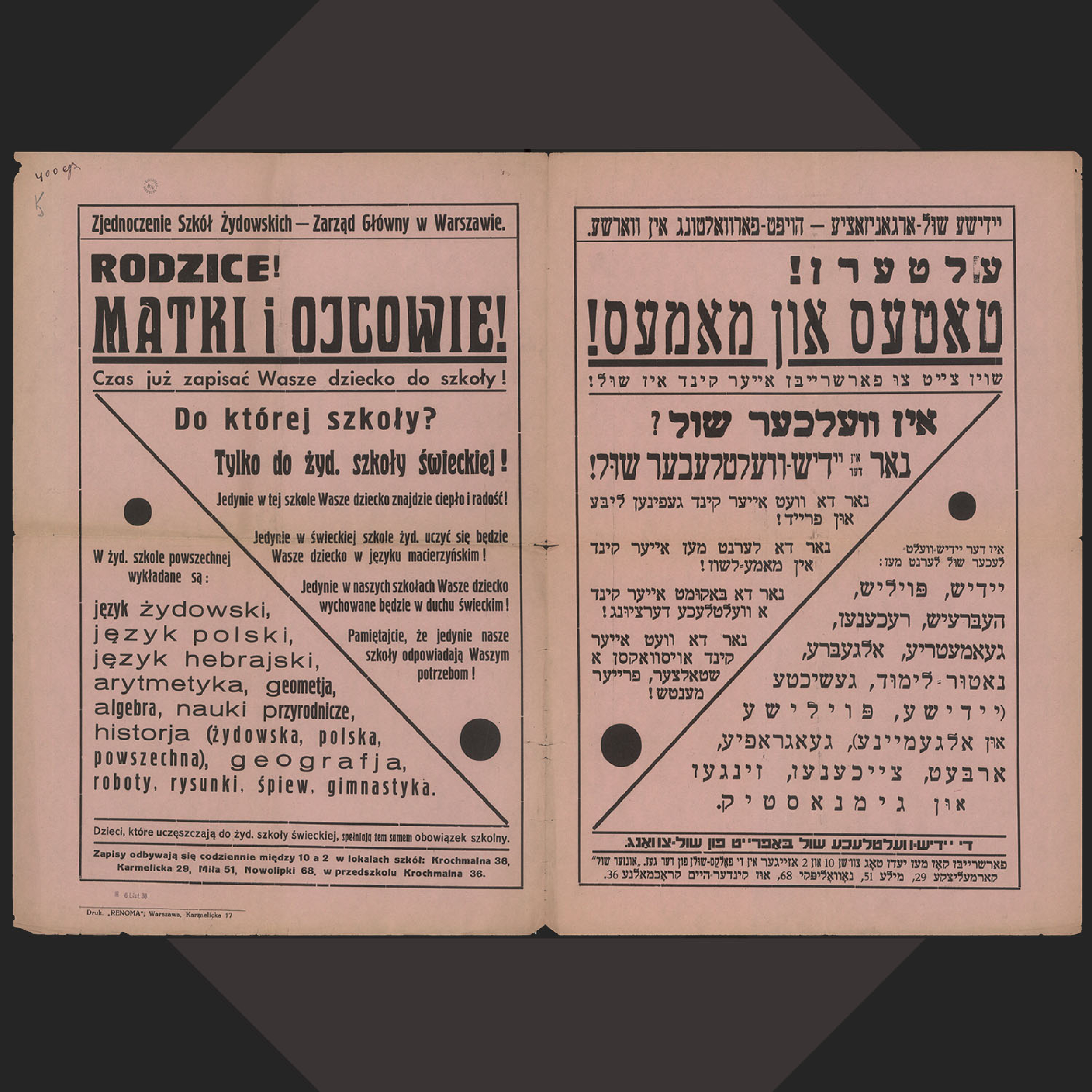Enroll your children in a secular Jewish school! The New Jewish School and Its Role in Educating a New Generation of Jews in Poland

|
Max Weinreich Fellowship Lecture in Polish Jewish Studies
The Aleksander and Alicja Hertz Memorial Fellowship and the Samuel and Flora Weiss Research Fellowship Admission: Free |
This lecture will be delivered in Yiddish.
"פֿאַרשרײַבט אירע קינדער אין דער ייִדיש־וועלטלעכער שול!" די נײַע ייִדישע שול – איר ראָלע אין דער דערציונג פֿונעם נײַעם ייִדישן דור אין פּױלן 1921-1939
מיט 100 יאָר צוריק איז אַנטשטאַנען אין וואַרשע די צענטראַלע ייִדישע שול אָרגאַניזאַציע (צישאָ) וואָס אונטער איר השגחה האָבן זיך געזאַמלט אַלע ייִדיש־וועלטלעכע שולן אין פּױלן. די אָרגאַניזאַציע איז געווען אַ קאָמפּראָמיס צווישן שול־ און כּלל־טוערס וואָס זענען געווען פֿאַרבונדן מיט פֿאַרשײדענע פּאָליטישע פּאַרטײען, ס׳רובֿ מיטן בונד, לינקע פּועלי־ציון, פֿאָלקס־פּאַרטיי ווי אויך אָנהענגערס פֿון דער דעמאָקראַטישער שולע. אײן חלום האָט זיי אַלע פֿאַראייניקט – צו שאַפֿן אַן אײנהײטלעכע וועלטלעכע שולע וווּ די קינדער פֿון דער ייִדישער גאַס וועלן זיך לערנען אין זײער מאַמע־לשון. די סאַמע גרינדונג פֿון צישאָ איז בלויז געווען אַן אָנהײב – די נײַע שולע האָט גאָרניט נישט געהאַט – ניט קײן אױסגעשולטע לערערס, ניט קײן שול־לאָקאַלן, ניט קײן לערנביכער און פּעדאַגאָגישע ליטעראַטור, נישט קײן אָנגענומענע טערמינאָלאָגיע צו לערנען איינצעלנע לימודים אױף ייִדיש, ניט קיין געלט און אפֿילו ניט קיין עגזיסטענץ־ רעכט. פֿאַר דעם אַלעם האָט מען געדאַרפֿט קעמפֿען – דאָס איז געווען די ראָלע פֿון צישאָ און דאָס האָבן טאַקע געטאָן אירע אַקטיוויסטן בשעת די כּמעט 20 יאָר פֿון איר טעטיקײט אין פּױלן.
נאָר אַ קליינער פּראָצענט פֿון די ייִדישע קינדער אין פּױלן האָט באַזוכט אײן פֿון די צישאָ־שולן. צי דאַרף מען אָבער גלױבן נאָר די פּראָצענטן? אַ סך קינדער אין מיזרח־פּוילן זענען יאָ געווען תּלמידים פֿון אַ ייִדיש־וועלטלעכע שולע און זי באַשריבן ווי אַ צווייטע הײם – דאָרטן האָבן זיי זיך צום ערשטן מאָל געטראָפֿן מיט די וועלטלעכע לימודים – זיך באַקענט מיט דער וועלטלעכער ייִדישער ליטעראַטור און קולטור, מיט דער ייִדישער געשיכטע, מיט דער אַרומיקער נאַטור. זיי האָבן זיך געלערנט צו דיסקוטירן און אַלײן אָננעמען אַ באַשלוס. דאָרטן האָבן זיי אַנטדעקט זייערע פֿעיִקײטן און זײ אַנטוויקלט, למשל בײַם צוגרייטן עקספּאָנאַטן פֿאַר דרײַ גרױסע שול־אױסשטעלונגען, וואָס געווידמעט די ווײַטערדיקע טעמעס: מענדעלע מוכר־ספֿרים (1936), שלום־עליכם (1937) און ייִדן אין פּױלן (1939).
וואָס איז געווען אַזױ באַזונדערס אין די צישאָ־שולן און וואָס פֿאַר אַ השפּעה האָבן זיי געהאַט אױף זייערע תּלמידים? בשעת דער לעקציע וועלן מיר זוכן ענטפֿערס אױף די פֿראַגעס אויפֿן סמך פֿון דער אַרבעט פֿון דער ייִדישער וועלטלעכער שולע אין פּרוזשאַנע, וואָס איז באַשריבן געוואָרן אי דורך אַ לערער, נוח צוקערמאַנען, אין זײַנע בריוו צום פֿאַרוואַלער פֿונעם ייִדישן לערער־סעמינאַר אין ווילנע אבֿרהם גאָלאָמבן אי דורך אַ תּלמיד – וועלוול קאַפּלאַנסקי, וועלעכר האָט וועגן איר געשריבן אין זײַן אױטאָביטגראַפֿיע צוגעשיקט פֿאַר אַ קאָנקורס פֿון ייִוואָ.
One hundred years ago, the Central Jewish School Organization (TSYSHO) was established in Warsaw, uniting a number of secular Jewish schools and using Yiddish as its language of instruction. A compromise made between different school and community activists associated with various political parties, mostly the Bund, the Left Poale Zion, the Folkspartei and the supporters of democratic school, they shared the same dream – to create a unified, secular school where children from the Yidishe gas, or the Jewish Street, would receive instruction in their native language. The creation of TSYSHO was only the beginning. But the new school organization lacked everything it needed: educated teachers, premises, textbooks and pedagogical literature, even the educational vocabulary required to teach particular subjects in Yiddish. It also had no money and did not even have the right to exist. All of the above had to be fought for, and this was the role of TsYSHO, and precisely what the party's activists did during the nearly twenty years of its existence in Poland.
Only a small percentage of Jewish children in Poland attended the TSYSHO schools. But should one believe the numbers? Many children in eastern Poland were students at a secular Jewish school and described it as their second home. It was there that they first became acquainted with secular subjects, secular literature and culture, Jewish history and the natural environment surrounding them. They learned to discuss all manner of things and make decisions on their own. They also discovered and developed their skills and abilities, for example, by preparing exhibits for three large school exhibitions devoted to the life and work of Mendele-Moykher Sforim (1936), Sholem Aleykhem (1937) and Jews in Poland (1939).
What was so special about TSYSHO schools and what impact did they have on their students? During this lecture, we will look for answers to these questions based on the activity of the secular school in Pruzhany, which was described by both the teacher Noach Tsukerman in his letters to Abraham Golomb, the director of the Jewish Teachers' Seminary in Vilna, and his student Velvel Kaplanski, who wrote about it in his autobiography submitted to the YIVO competition.
About the Speaker
אַניאַ שיבאַ האָט שטודירט קולטור און ייּדישע געשיכטע. ביזן יאָר 2015 האָט זי געאַרבעט אין צענטער פֿאַר ייִדישער קולטור אין וואַרשע, אַוווּ זי האָט אָנגעפֿירט מיט אַ ריי קולטור־ און בילדונג־פּראָיעקטן און געלערנט ייִדיש. הײַנט איז זי אַ דאָקטאָראַנטקע אין דעם פֿרײַען אוניווערסיטעט אין בערלין און שרײַבט וועגן נײַע ייִדיש־וועלטלעכע שולן אין פּױלן פֿאַר דער צווייטער וועלט־מלחמה. וועגן דער טעמע האָט זי שוין פֿאַרעפֿנטלעכט עטלעכע אַרטיקלען אויף פּויליש און דײַטש.
Anna Szyba has studied both Cultural Studies and Yiddish Studies and worked in the Center for Yiddish Culture in Warsaw. Currently she is a PhD candidate in the Institute for East European Studies at the Free University of Berlin, where she conducts a research about pedagogical methods used in schools of the Central Yiddish School Organization (TSYSHO).




